MARK BANDO'S WEBSITE
The Battle of Longchamps
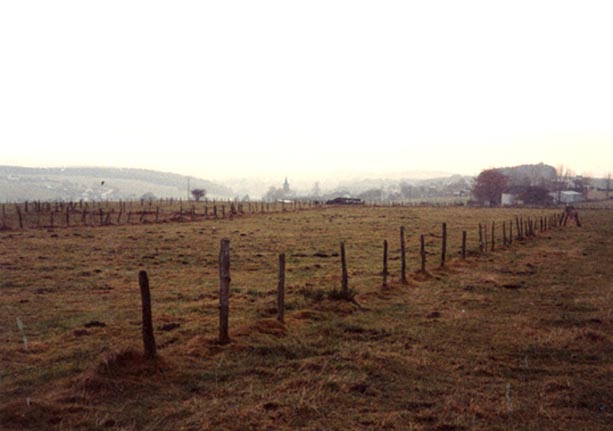 The historic Battle of Bastogne lasted from mid December 1944 to mid January 1945. American forces formed a perimeter completely around the town, with an infantry line several miles outside the town proper. Elements of eight German divisions surrounded Bastogne for several weeks, trying unsuccessfully to capture it with attacks from various directions
around the circle. Seldom were two attacks launched in different sectors at the same time. The photo at the heading of this story was taken in 1994, by Alden Todd of F/502. This is the Longchamps battlefield, which had changed little in fifty years, but during the battle, the area was blanketed in snow.
The historic Battle of Bastogne lasted from mid December 1944 to mid January 1945. American forces formed a perimeter completely around the town, with an infantry line several miles outside the town proper. Elements of eight German divisions surrounded Bastogne for several weeks, trying unsuccessfully to capture it with attacks from various directions
around the circle. Seldom were two attacks launched in different sectors at the same time. The photo at the heading of this story was taken in 1994, by Alden Todd of F/502. This is the Longchamps battlefield, which had changed little in fifty years, but during the battle, the area was blanketed in snow.
January 3, 1945 was one of the few times during the siege of Bastogne in which the Germans struck two different parts of the perimeter simultaneously. While elements of the 12th SS Panzer Division struck the NE perimeter in the 501 PIR sector, the 19th SS Panzer Grenadier Regiment of the 9th SS Division, was attacking the NW perimeter, between Monaville-Longchamps. This tough German outfit was part of the II SS Panzer Corps, and had fought in Russia as well as Normandy (against the British below Caen). It had been refitting in the Arnhem area in September and played a major role in decimating the British Airborne during Market-Garden. The unit had then taken up positions in the Westwall, near Aachen, before entering the Ardennes Offensive in December.
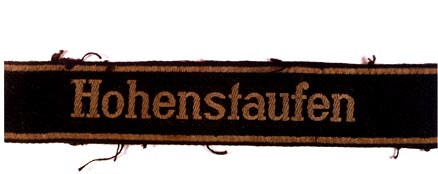 The 9th Panzer Division of the Waffen SS was known as "Hohenstaufen", a name they wore on their left sleeve. The
original wearer of this example was killed in the Siegfried Line in the fall of 1944, after defending Arnhem, but before the Bulge. This example comes from Captain Chuck Bult of the U.S.
2nd Armored Division.
The 9th Panzer Division of the Waffen SS was known as "Hohenstaufen", a name they wore on their left sleeve. The
original wearer of this example was killed in the Siegfried Line in the fall of 1944, after defending Arnhem, but before the Bulge. This example comes from Captain Chuck Bult of the U.S.
2nd Armored Division.
On the evening of 2 January, 1945, a runner from the 9th SS Division was captured near Longchamps, Belgium, with a case full of attack plans for 3 January in his possession. American artillery was concentrated on the staging area for the attack and caused considerable disruption. This was fortunate, because even with that, the 9th SS launched a powerful tank and infantry attack against the 2/502 on 3 January.
THE WHITE FANG
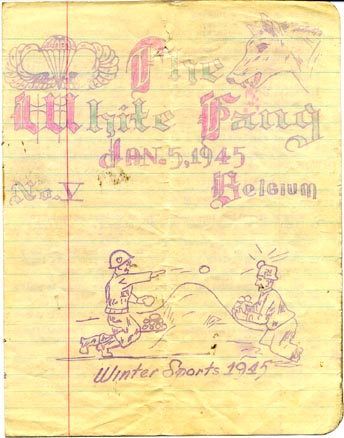 Some members of the 502's 2d Bn HQ published a newsletter for the frontline troops of the 2/502 from January 1-10th, 1945, entitled The White Fang. This little news sheet was mimeographed on both sides of a piece of folded, lined notebook paper, with a different illustration on each day's cover. The 'White' in the title comes from second battalion, as the PIR battalions, (1st 2nd and 3rd) were always coded red, white and blue. The White Fang was heavily laced with humor and sexual inuendo, and a disclaimer at the front of each issue proclaimed: "The editors of this paper will not accept responsibility for rumors, slander, errors, and will not engage anyone in a duel with firearms or knives. This is a daily paper for The'Boys with the Shiny Boots'". Issue No.4 of White Fang, depicted above, courtesy John Seney 2/502, who was a writer on the White Fang staff. His editorial in the January 4, 1945 issue described the fight at Longchamps in a more serious fashion:
Some members of the 502's 2d Bn HQ published a newsletter for the frontline troops of the 2/502 from January 1-10th, 1945, entitled The White Fang. This little news sheet was mimeographed on both sides of a piece of folded, lined notebook paper, with a different illustration on each day's cover. The 'White' in the title comes from second battalion, as the PIR battalions, (1st 2nd and 3rd) were always coded red, white and blue. The White Fang was heavily laced with humor and sexual inuendo, and a disclaimer at the front of each issue proclaimed: "The editors of this paper will not accept responsibility for rumors, slander, errors, and will not engage anyone in a duel with firearms or knives. This is a daily paper for The'Boys with the Shiny Boots'". Issue No.4 of White Fang, depicted above, courtesy John Seney 2/502, who was a writer on the White Fang staff. His editorial in the January 4, 1945 issue described the fight at Longchamps in a more serious fashion:
"Yesterday, around 1230, the enemy attacked our positions with approximately 28 tanks and one battalion of infantry. Their tanks broke through and overran our lines, but the line held and repulsed the enemy with heavy casualties and then set out to destroy their tanks. Jerry tried everything in the books, but the Eagle Division taught Jerry a costly lesson in tanks and men. The enemy kept up an almost constant barrage with their artillery, mortars, and screaming meemies.
The account was collected in the heat of battle so cannot be too accurate in the details of yesterdays and todays battle. But your reporter does know that the Boys with the Shiny boots can still hold their heads high and walk as only a trooper can who knows he is the best.
There were many cases of individual heroism which cannot be published until a later date.
A few of the dirty and begrimed men I talked to told of Jerries kicking men and backing over holes with tanks time and again,
trying to crush our men in their holes. I saw some of the men who returned from the hill they are defending with their shoulders slightly bowed and their faces dirty, clothes soaking wet from lying in the snow and on the damp ground. But yet they
all had that proud gleam in their eye and they would pull back their shoulders, report, and then move out to battle the enemy a few hundred yards distant.
You cannot write of action like this, of a few men holding back vastly superior numbers. The only men who came out of the line were the ones the medics carried out. Whenever you see a paratrooper walk down the street with that cocky way, and a fighting look, remember this, these men are the best damn soldiers in the world. They know it. That's why they are holding the line. If Jerry goes through, it WILL NOT be through the area they are defending."
From the webmaster: During this melee, Franklin "Ray" Blasingame, better-known as "Calfboy", was firing his bazooka at German S.P. guns which were passing on either side of his foxhole. With help from Bert Ellard, who alternated between picking off German Panzergrenadiers with his M-1, and acting as assistant bazookaman, Ray hit six German tanks with bazooka rockets as they passed broadside, disabling two. He was also busy with his carbine, shooting German infantry. Ellard told me the fact that these were S.P. guns, without traversible turrets, saved him and Blasingame from probably lethal 75mm retaliatory fire. Calfboy later received the Silver Star for his actions that day. He and Ellard were able to avoid being captured although many of their buddies were taken prisoner that day. In a well-known incident during this battle, a German tank parked over the foxhole of radioman Lawrence Silva, and killed him by flooding his hole with carbon monoxide exhaust fumes.
In "Rendezvous With Destiny", Leonard Rapport writes: "It was a day productive of fear, frustration, and bravery. Pfc Bruno J. Mecca, of Company D, whose hole on the outpost line was early overrun, came back to the C.P. that night with tears in his eyes: "I'll fight any son of a bitch, but I can't fight those goddam tanks with a carbine."
Although the White Fang account does not mention it, many members of F 502, including Lt Earl Hendricks, the company commander, were captured right on the MLR that day. Some F company men were killed or wounded by American artillery fire soon after surrendering. Garson "Bull" Durham was among those killed. All the Americans who were taken prisoner were already wounded when captured. The PWs were marched most of the way to Gerolstein, Germany in the snow. The Germans had more Panzer troops than they had vehicles for them to man, so some attacked with the infantry. Their stark black uniforms made excellent targets against the white snow, and after the battle, their bodies dotted the large valley north of the American foxhole line. A significant number of the 6,700 Germans buried in the Recogne, Belgium military cemetery were killed above Longchamps. This was the 'Alamo' of the Battle of Bastogne.
More Tales From LongchampsT/4 John Seney was selected to act as bodyguard for LTC Thomas Sutliffe, 2/502 commander, as he 'trooped the line', inspecting frontline positions near Longchamps during a 'quiet' period. Seney later wrote: "While at Bastogne for the 'winter sports', the food situation was poor. Hunger gnawed my insides, the cold got my outsides, and fear had me by the ass." At one point, a sniper's bullet glanced off Sutliffe's map board. Seney began walking with knees bent, and hunched forward like Groucho Marx. Sutliffe said "Walk straight Seney, you're embarassing me."
Seney also wrote: "As we approached a bombed-out house, the almost forgotten odor of hamburgers assaulted my proboscus. While the Brass were conferring, I went into the house and found Joe Pistone of F company cooking five Honest to God hamburgers.
Outside of cannibalism, there had been no meat around for a week. I asked, then begged for a hamburg. Joe's reply was "Sorry-they're all spoken for." I suggested he break a little piece off the edge of each of them, saying-'they'll never know the difference.' After approximately an hour, I gave up."
19 years later, Joe brought 5 pounds of hamburger over to his neighbor John's house-his conscience wouldn't let him rest.
John's reaction: "Too little, too late."
John concluded: "I want to warn you not ever to go on a picnic with anyone from F company. Remember the old cry 'F company did it!'(they probably did). I know any former lieutenants reading this will blanche and shake at the mere mention of the name. If
you ever get into trouble, get a few F company guys together. If it can be moved or stolen, they will get it for you."
In the Perimeter of BASTOGNE
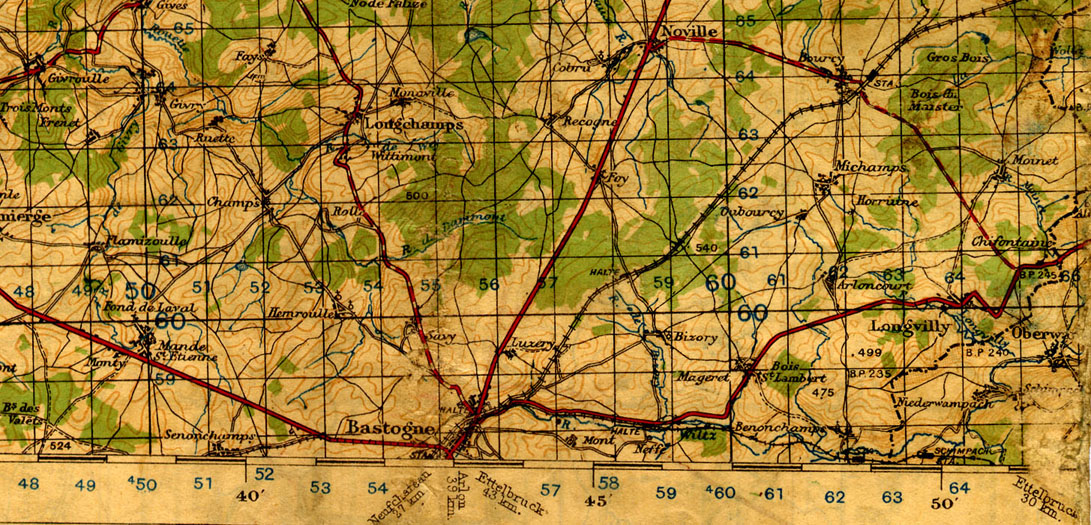 The WW2 vintage map illustrated above is from the 1:100,000 scale map of Marche, Belgium, and it shows most of the important places in the U.S. perimeter encircling besieged Bastogne, Belgium, in December, 1944. Map courtesy of Captain Joe Pangerl, 502 IPW team #1.
The WW2 vintage map illustrated above is from the 1:100,000 scale map of Marche, Belgium, and it shows most of the important places in the U.S. perimeter encircling besieged Bastogne, Belgium, in December, 1944. Map courtesy of Captain Joe Pangerl, 502 IPW team #1.
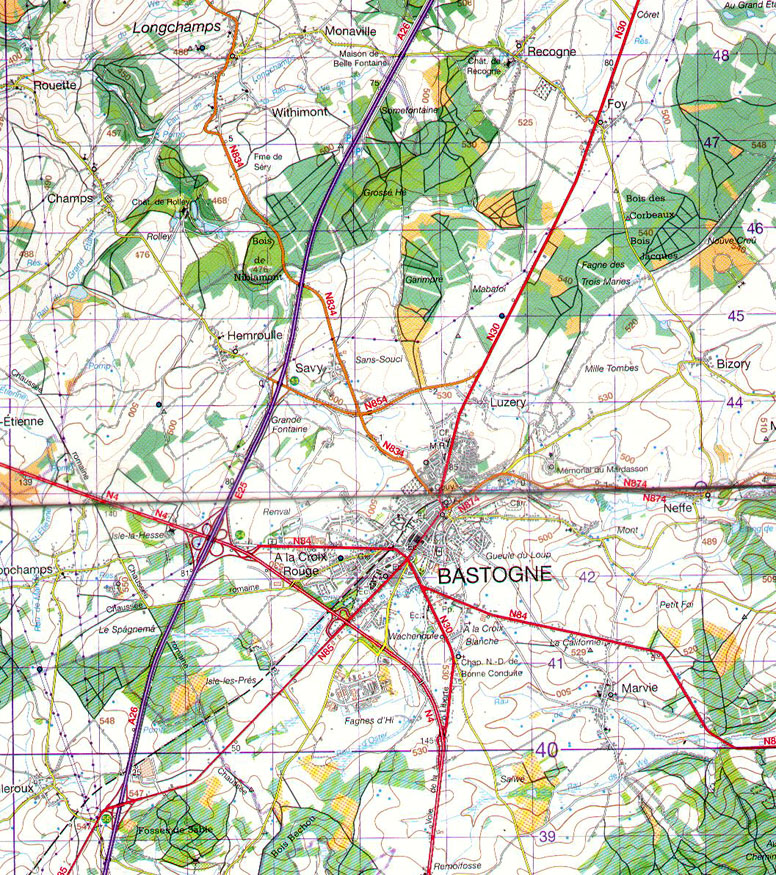 The village names are clearer in this modern map, provided for comparison purposes courtesy Johann Willaert.
The village names are clearer in this modern map, provided for comparison purposes courtesy Johann Willaert.








